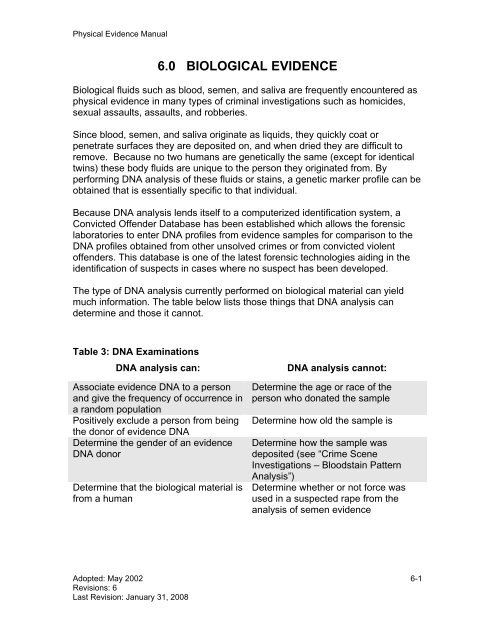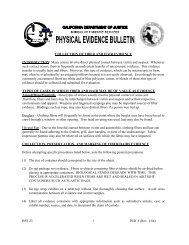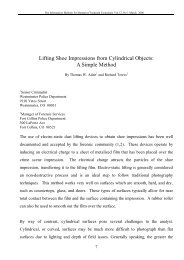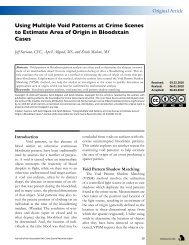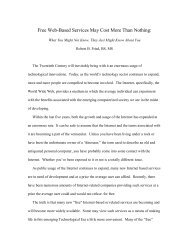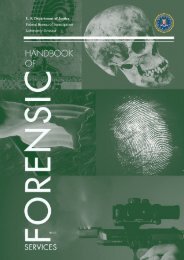PHYSICAL EVIDENCE MANUAL - Crime Scene Investigator Network
PHYSICAL EVIDENCE MANUAL - Crime Scene Investigator Network
PHYSICAL EVIDENCE MANUAL - Crime Scene Investigator Network
Create successful ePaper yourself
Turn your PDF publications into a flip-book with our unique Google optimized e-Paper software.
Physical Evidence Manual<br />
Adopted: May 2002<br />
Revisions: 6<br />
Last Revision: January 31, 2008<br />
6.0 BIOLOGICAL <strong>EVIDENCE</strong><br />
Biological fluids such as blood, semen, and saliva are frequently encountered as<br />
physical evidence in many types of criminal investigations such as homicides,<br />
sexual assaults, assaults, and robberies.<br />
Since blood, semen, and saliva originate as liquids, they quickly coat or<br />
penetrate surfaces they are deposited on, and when dried they are difficult to<br />
remove. Because no two humans are genetically the same (except for identical<br />
twins) these body fluids are unique to the person they originated from. By<br />
performing DNA analysis of these fluids or stains, a genetic marker profile can be<br />
obtained that is essentially specific to that individual.<br />
Because DNA analysis lends itself to a computerized identification system, a<br />
Convicted Offender Database has been established which allows the forensic<br />
laboratories to enter DNA profiles from evidence samples for comparison to the<br />
DNA profiles obtained from other unsolved crimes or from convicted violent<br />
offenders. This database is one of the latest forensic technologies aiding in the<br />
identification of suspects in cases where no suspect has been developed.<br />
The type of DNA analysis currently performed on biological material can yield<br />
much information. The table below lists those things that DNA analysis can<br />
determine and those it cannot.<br />
Table 3: DNA Examinations<br />
DNA analysis can: DNA analysis cannot:<br />
Associate evidence DNA to a person<br />
and give the frequency of occurrence in<br />
a random population<br />
Positively exclude a person from being<br />
the donor of evidence DNA<br />
Determine the gender of an evidence<br />
DNA donor<br />
Determine that the biological material is<br />
from a human<br />
Determine the age or race of the<br />
person who donated the sample<br />
Determine how old the sample is<br />
Determine how the sample was<br />
deposited (see “<strong>Crime</strong> <strong>Scene</strong><br />
Investigations – Bloodstain Pattern<br />
Analysis”)<br />
Determine whether or not force was<br />
used in a suspected rape from the<br />
analysis of semen evidence<br />
6-1


